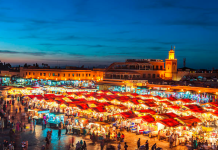Comment on this story
Comment
BANGKOK —Beaches brimming with sunbathers. Coves crowded with boats and snorkelers. Trails busy again with hikers and their porters.
More than two years after the coronavirus pandemic brought international travel to a halt, most countries in Southeast Asia have reopened their borders with minimal requirements for vaccinated travelers. Millions arrived over the summer, fueled by pent-up wanderlust. The return of these tourists is a relief for an economically battered region — but it comes with its own costs.
While the pandemic crippled Southeast Asia’s $393 billion tourism industry and erased millions of jobs, it also allowed many of its natural landscapes and heritage sites to recover from years of being trampled and polluted. Now, some government officials and community leaders are pushing against a return to the unbridled tourism that scientists warned for years was causing irreparable environmental harm. At the same time, those who rely on tourist revenue are desperate to welcome back visitors — as many of them as possible.
“The industry is very much in flux right now,” said Liz Ortiguera, chief executive of the Pacific Asia Travel Association, a nonprofit that advocates for sustainable travel. A growing number of governments and businesses are asking for ways to make tourism less destructive, she said, but as the pandemic fades, the revival of some ecologically damaging mass tourism is “a given.”
A month after Thailand closed its borders in 2020, a herd of dugongs — among the most endangered marine mammals in the world — were seen floating serenely in the shallow waters off the country’s southern coast. Leatherback turtles took the place of tourists in Phuket, nesting on the beaches at rates that shocked local scientists.
“The pandemic was an excellent opportunity, in a way, to show what happens when humans are able to give nature a break,” Varawut Silpa-archa, Thailand’s minister of Natural Resources and Environment, told The Washington Post.
In 2020, Thailand closed all 155 of its natural parks to visitors for the first time ever. While they were reopened in July, Silpa-archa has ordered that every park shut down for at least a month every year. He has also banned single-use plastics from the parks and said he “will not hesitate” to shut down a destination long-term if tourists wreak havoc. He has little concern for potential opposition from businesses.
“To be blunt, I really don’t care if they agree,” he said. “My job is to preserve nature for our future generations.”
Recent attempts by other countries to regulate tourism have been less successful. In June, Indonesian officials ran into local opposition after proposing that visitors to the ancient Borobodur Temple in Java be limited to 15 at a time and that tickets for foreigners be raised from $25 to $100 to fund conservation. When the government announced plans to hike ticket prices for the Komodo National Park in East Nusa Tenggara, hundreds of tourism workers went on strike. Price increases for both locations are now on hold.
“The challenge,” said Steven Schipani, a tourism industry specialist at the Asian Development Bank, “is that there’s so much sunk investment.”
The number of annual tourist arrivals to Southeast Asia doubled from 2010 to 2019, peaking just before the pandemic at 137 million. This growth was expected to continue at least until 2030, in large part because of a rising regional middle class. In Southeast Asia, businesses and government agencies made major investments to prepare for and profit off these visitors. Much of that infrastructure — airports, hotels, sewage systems — is still in place, said Schipani.
“There’s capacity for 140 million people,” he noted. And there’s “immense pressure” to make sure that capacity is fulfilled.
In 2018, then-Philippines president Rodrigo Duterte closed the white sand island of Boracay for six months, saying overtourism had transformed it into a “cesspool.” Since reopening, the island has kept certain sustainability measures in place, though these are now being tested. Over Easter weekend in April, Boracay exceeded its daily visitor cap multiple times, authorities said.
Nowie Potenciano, 44, runs several restaurants and a boutique hotel on the island. The tourists returning to Boracay in recent months have been quite literally “hungry” for new experiences, he said, with many ordering more food than they might have in the past. He’s glad they’re back but doesn’t think things can return to “business as usual” post-pandemic.
“It’s something we’re all still figuring out,” Potenciano said. “How do we maintain the volume of visitors without upsetting the delicate balance of the entire island?”
In 2019, nearly 40 million tourists visited Thailand, and many spent time along its dazzling Southern coast. Research shows that from 2017 t0 2019, at least two locations in the south — Patong Beach and Maya Bay — regularly exceeded their “carrying capacity,” which refers to the number of people a place can reasonably accommodate without damaging the environment or local community.
Somyot Sarapong, who works for an ecotourism agency in Bangkok, lived and worked on the Phi Phi Islands in the 1990s but left in 2003 when outside developers started to erect tall, concrete hotels on the beachfront that displaced locally run resorts. When Sarapong, 56, returned in 2019 to visit friends, he no longer recognized the place he used to consider a “slice of heaven.” Brightly colored fish, once so abundant, had become hard to spot.
Sarapong made another trip to the islands earlier this year before Thailand reopened its borders to international visitors. While swimming in the sea, he saw a swarm of blacktip reef sharks, which had become increasingly rare around the islands before the pandemic.
“It gave me the feeling of my first day at Phi Phi,” Sarapong said.
Sarapong wants to see the government do more to stave off overtourism, though some experts in sustainability are skeptical that officials will do what’s necessary.
Thailand is renowned for its hospitality and counted on tourism for 11 percent of its gross domestic product pre-pandemic. Like many countries in Southeast Asia, it lacks the kind of zoning, land use regulations and hotel permitting that would allow the government to effectively manage the impact of tourism, experts say, even if there was political will.
But Thon Thamrongnawasawat, a marine scientist at Kasetsart University in Bangkok, believes there’s reason to be optimistic.
“When you drive at a very high speed, it’s hard to slow down. With covid, it’s like the car engine stopped,” he said. “Now we’re starting again and we can go carefully, slowly.”
The pandemic allowed more Thai people to reacquaint themselves with the beauty of their own country, Thamrongnawasawat added. When it comes to protecting it now, he added, “we have a much, much better chance than before.”
Regine Cabato reported from Manila. Wilawan Watcharasakwet contributed reporting from Bangkok.













